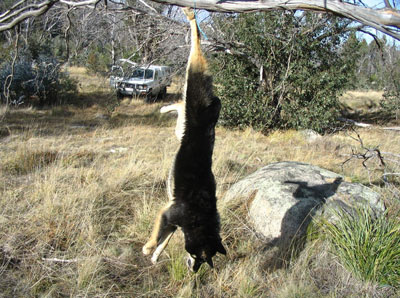
| Australian farmers wrestle dingo threat
GUDGENBY VALLEY, Australia, (Reuters) - Between grey granite mountains and drought-ravaged farms is a strip called the "militarised zone", the frontline of a battle between farmers and environmentalists over the survival of Australia's dingo. "In that zone no dog may live. It gets killed if it gets in that place," says senior parks ecologist Don Fletcher, bluntly laying bare the strategy to protect vulnerable sheep grazing flocks from Australia's top predator. Dingoes are part dog, part wolf, a last remnant of Asia's ancestor to modern dogs. Their place in Australian folklore was secured by a sensational 1980's murder case involving baby Azaria Chamberlain, whose parents said she was taken by a dingo. The animals range from here in the foothills of the rugged southeastern alps to the desert outback, preying on larger animals like kangaroos. But environmentalists fear dingoes are at risk of extinction not only from farmers, but from interbreeding with ordinary dogs introduced by European settlers over 200 years ago, weakening their 3,500-year-old genetic line. And while protected inside parks, World Heritage areas and Aboriginal reserves, dingoes to many graziers are a pest, savaging flocks already under stress from a 10-year drought. "They absolutely torture them, they eat them alive, they'll just pull them down and just eat the back legs, hamstrings out of them, they'll eat the flanks out and tear the guts out and then they'll go on to another one," says Harley Hedger, who hunts dingoes and wild dogs on contract for angry farmers. Trapping Dingoes Burly government trapper Mick Clarke controls dingoes inside the zone. Conservationists say the strip buffers a mountain park sanctuary of near genetically-pure dogs, and keeps farmers and environmentalists from each others throats. It is a charged job to make all sides happy. Clarke, who respects his adversary, squats to lay a rubber-jawed trap before setting a white Cockatoo bird feather to sway in the breeze and draw in a curious dingo. Around the trap goes a square of sticks. "The dingoes don't like to step on anything round. They step over the stick and bang, they hit the trap," Clarke says, drawing on 30 years of experience trapping wild dogs. "Without seeing them I know where they live, what they like and even how big they are. The only thing I don't know before I catch them is their colour." To help, Clarke has Jess, a grizzled dingo adopted as a pup to help control the impact of dogs on local sheep flocks. "She's almost pure. When she goes bananas in the back of the truck I know where the wild ones are," Clarke says. Every dog or dingo shot by Clarke is photographed, weighed and sent to researchers who track changes to dingo bloodlines. By the early 1990s, around a third of all wild dingoes in Australia's southeast were crossed with domestic dogs. In 2004 dingoes were tagged officially as "vulnerable" to extinction. That has not stopped Victoria state placing a A$50 ($42) bounty on the heads of all wild dogs in a move critics say will speed their demise. Animal lovers accused the state government of pushing dingo populations to extinction. The government argues the bounty will help eliminate feral dogs and foxes from parts of the state ravaged by bushfires in December and January, helping the recovery of farmland. Rogue dogs Some farmers support dingo sanctuaries, but others demand they be shot, trapped or poisoned, inside or outside protected national park borders."You've got the ones that will not allow any control on their property, right through to ones who will call for any measure, everywhere, anytime," Fletcher says. But most problems, rangers say, are caused by rogue dogs or dingoes who for unknown reasons abandon traditional prey. Those rogue dogs pose the biggest headache for Clarke, mainly because dingoes are also highly intelligent."They learn your methods and adapt, which means you have to try new stuff yourself," he says. "You set your traps at one end of a property after a series of attacks and the dog will attack the other end. But you get them eventually," he adds. Near Canberra around 40 dog attacks occur each year, some of which go unnoticed until farmers muster and count sheep flocks left to graze in the mountains. "At times they will kill more than they eat. Whether that's training their young, having fun, we don't know," Fletcher says. For Clarke, who shoots the dingoes he catches, there is little joy in killing the animals, despite his acceptance it is necessary. "I don't like killing them to be honest. They are very intelligent and are a part of the land. There is just something about them that's different," he says. |
| || Front
Page | News
| Editorial
| Columns
| Sports
| Plus
| Financial
Times | International
| Mirror
| TV
Times | Funday
Times || |
| |
Copyright
2007 Wijeya
Newspapers Ltd.Colombo. Sri Lanka. |
